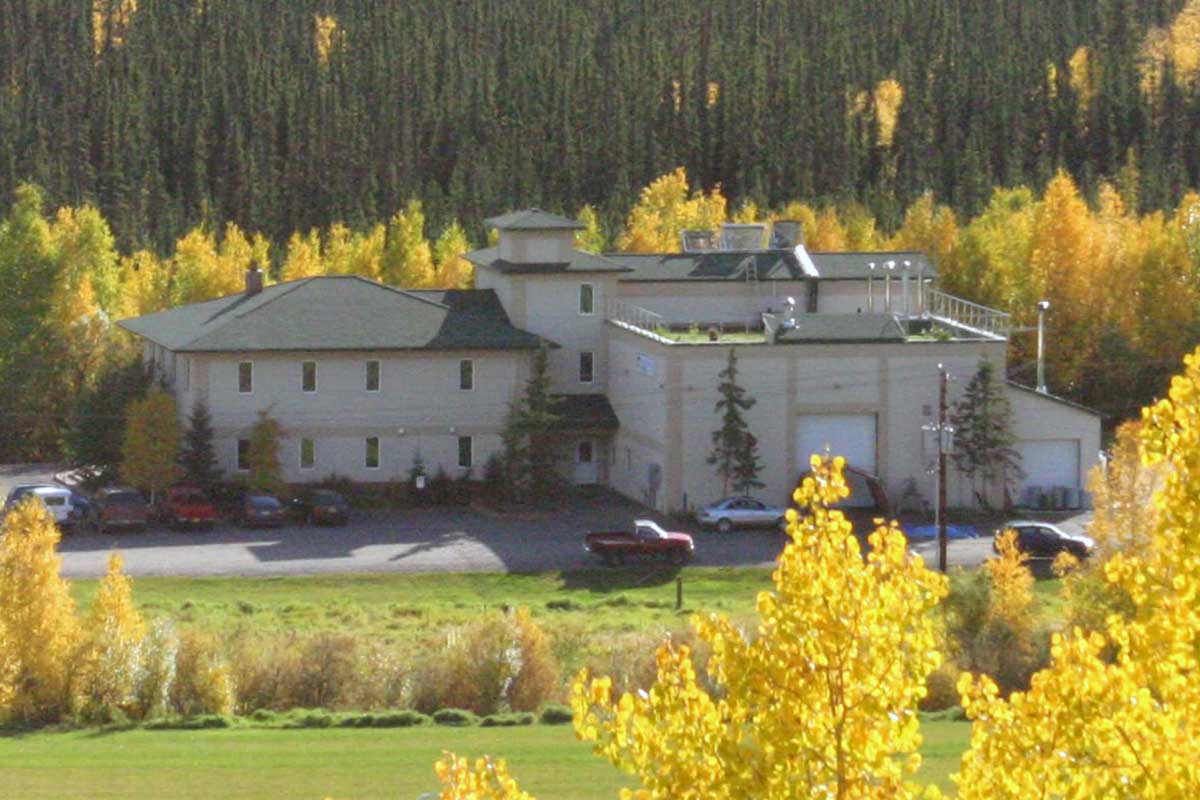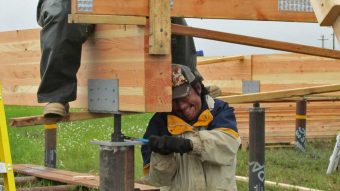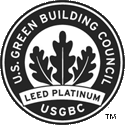CCHRC’s Research and Testing Facility is the farthest-north LEED Platinum building on earth. Our 22,000 square foot building incorporates cutting-edge building and energy technologies – such as an adjustable foundation, a ground source heat pump, a solar thermal storage system, and hundreds of sensors – as a demonstration of what’s possible in cold climate housing. Through a focus on energy efficiency and resources like solar, geothermal and biomass, the Research and Testing Facility is approaching net-zero heating in a subarctic climate.
Constructed in 2006, the Research and Testing Facility provides office and lab space for CCHRC and its partners to manage and carry out building and energy research and product testing. It also provides classroom, library, meeting, and demonstration space.
CCHRC secured over $5.2 million in public and private funds, material, and in-kind donations to design and build the RTF. This includes the construction of a 15,000 square foot facility comprised of two large test bays, office space, classrooms, a library, and space for power generation, as well as access roads, storm and waste water treatment, and water storage to support the facility.
USDA-Rural Development was the most significant contributor to the original project. Without generous support from them and others, the project would not have been possible. A 8,000 square foot addition was added in 2013 to provide additional classroom, design, and collaborative space, with funding from the U.S. Economic Development Administration and the Rasmuson Foundation.
**The Cold Climate Housing Research Center works throughout the traditional territories of the Indigenous Peoples of Alaska. Our research center is on the homeland of the Lower Tanana Dene Athabaskans. We thank and respect the First Alaskans for their ancestral and present land stewardship and place-based knowledge.**

Research & Testing Facility Building Systems
As in any building, CCHRC has a number of components that work together as a system to maximize efficiency, comfort and safety of the occupants.
Research & Testing Facility Legacy Monitoring
More than 400 sensors have been installed in the RTF to make it a living demonstration of building system operations and performance. Michael Lilly of GW Scientific is working with us to monitor this data.
The following products will form the basis of the RTF Legacy Monitoring program:
- Report summarizing brainstorming, data gathering, and synthesis efforts
- METADATA Guidelines Manual
- Data Quality Assurance and Quality Control Manual
- Data Network Operations and Maintenance Guide
- Report on educational, training, and outreach recommendations
We will optimize the current monitoring plans into a long-term program. What we learn will be combined with recommendations from statewide surveys and brainstorming, and applied to projects around the state. The development of an RTF Legacy Monitoring Program serves as a foundation for evaluating future proposals and funding efforts.
Partners on this Project
Solar Thermal at CCHRC
The CCHRC Research and Test Facility currently has two solar thermal systems installed and operational. They consist of the two basic market leading technologies for the production of hot water in residential applications. One collector is an evacuated tube (heat pipe) type consisting of a 20-tube arrangement with a pump-station and a differential pump controller. The other collector is a 4’x8’ flat plate type with an integral photovoltaic panel (PV) that powers a DC pump.
The flat plate collector is the oldest and most predominant type of solar thermal system. CCHRC has only the one 4’x8’ unit, whereas a typical house would have two units in series. The system is antifreeze filled and uses the solar powered DC pump to move the fluid from the collector to the storage tank heat exchanger. No controls are used to operate the system. The photovoltaic panel is sized proportionately such that if there is enough sunshine to make a small amount of hot water, then the panel will provide enough power to pump the system by an equally small amount. As a result, the system is self-regulating and will operate in a power outage situation. This system heats only domestic water and has achieved temperatures in excess of 140° F.
A far north anomaly occurs in fall and spring when clear, sunny days combine with very cold outside air temperatures. The PV panel efficiency increases with cold temperatures, while the solar thermal collector efficiency decreases. As a result, the PV pump outperforms the system design thereby circulating hot glycol up to the cold collector where the heat is then radiated back to the atmosphere. This phenomenon is seasonal and short in duration, lasting from 2 to 20 minutes.
The evacuated tube system is more highly controlled and monitored. A sensor in the header at the collector determines a minimum turn on temperature. Sensors in the supply line, return line, and the storage tank, feed information to a differential temperature controller that operates a line voltage pump which transfers the heat to the storage tank. The concept of the evacuated tube design revolves around the ability to operate in lower ambient outside temperatures, as well as having the means to produce higher absolute water temperatures. As it is essentially operating inside an environment similar to that found within an insulated thermos bottle, the absorber heat pipe within the tube retains more of the incoming energy by not re-radiating back to the atmosphere as readily.
Should a power outage occur, the system will reach very high (250-300° F) “stagnation” temperatures. This has happened on one occasion. As previously mentioned, the collector can gather more heat from the sun in cold outside air conditions, provided the glass encasing the collector tubes remains clear of frost and snow.





